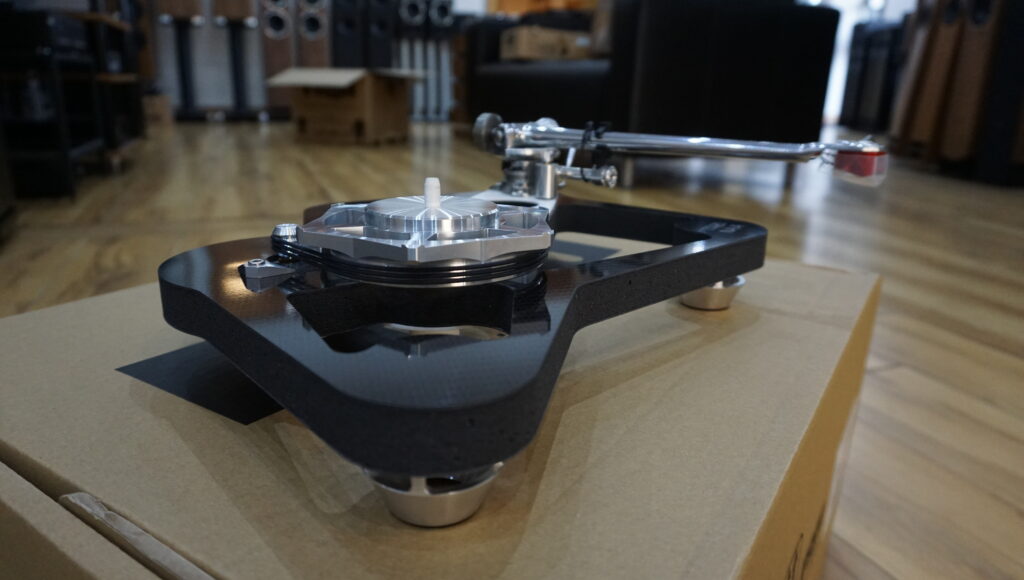
Few hi-fi companies inspire as much loyalty and debate as Rega Research, the British audio manufacturer known for its minimalist yet deeply considered turntable designs. Founded by Roy Gandy in 1973, Rega’s philosophy has always diverged from the mainstream of high-end audio. Where others add mass, damping, and complexity, Rega removes it. Where others strive for mechanical stillness through weight, Rega pursues speed, lightness, and rigidity.
At the heart of this approach lies a fascinating concept: Rega doesn’t really see their turntables as record players in the conventional sense. Instead, they describe them as “vibration measuring devices.”
This phrase captures the essence of Rega’s engineering worldview — that a turntable’s true job is not to create sound, but to measure the incredibly subtle vibrations engraved in a vinyl record with the utmost precision and minimal interference.
1. The Record Groove as a Measurement System
A vinyl record is, in essence, a storage medium for vibrations. When a record is cut, a lathe translates electrical signals (the music) into minute physical movements — tiny undulations in the groove walls. These modulations are on the scale of micrometers (millionths of a meter), and the playback stylus must faithfully follow these contours to recreate the original signal.
In this sense, playing a record is an act of measurement: the stylus is a sensor detecting mechanical vibrations, and the tonearm and turntable form part of a delicate measurement instrument.
Rega’s perspective follows naturally: if a turntable’s purpose is to measure vibration, then every design decision should aim to preserve the integrity of that measurement.
2. The Enemy: Unwanted Energy
To measure the groove’s vibrations accurately, the turntable must not add or subtract its own vibrations. Yet every mechanical system produces energy. Motors vibrate, bearings resonate, plinths flex, and sound from the speakers feeds back through the air and the support surface.
Traditional turntable design often seeks to combat this with mass damping — using heavy platters, suspended subchassis, and elaborate isolation systems to suppress or absorb unwanted vibration.
Rega’s approach is different. They believe that energy can never be fully damped — only controlled. Instead of trying to absorb vibration through mass, Rega designs their turntables to drain energy quickly and predictably away from the stylus–record interface.
3. Lightness, Rigidity, and Energy Control
Roy Gandy’s design mantra — “mass absorbs energy, rigidity controls it” — defines the company’s aesthetic and engineering language.
- Low mass: A lighter plinth stores less vibrational energy, meaning it returns less energy back into the system.
- High rigidity: A stiff structure allows vibrations to pass through it quickly and consistently, preventing delayed resonances or reflections that would smear the sound.
This is why Rega’s plinths are famously light and thin, often using a foam core sandwiched between stiff outer skins of phenolic resin. The result is a structure that behaves more like a tuned instrument than a lump of inert mass — responsive yet controlled.
Similarly, Rega’s tonearms (like the iconic RB300 and its descendants) are one-piece castings — another expression of this philosophy. By eliminating joints and using materials with high stiffness-to-weight ratios, Rega ensures that the stylus’s microscopic movements are transferred cleanly into electrical signal without distortion from mechanical instability.
4. The “Vibration Measuring Device” in Practice
When Rega calls a turntable a “vibration measuring device,” they’re emphasizing precision over artifice. Every element of a Rega deck — motor, bearing, platter, tonearm, plinth — exists to serve that single function: to measure the vibration encoded in the groove as faithfully as possible.
That means:
- The motor must rotate with extreme consistency (low wow and flutter).
- The bearing must introduce minimal friction and noise.
- The plinth must transmit energy efficiently without coloration.
- The tonearm must allow the stylus to track the groove with microscopic accuracy.
Rega even designs their cartridges and tonearms as integrated systems, minimizing energy reflections at the mounting point and maintaining mechanical coherence from groove to signal output.
5. A Philosophical Position, Not Just an Engineering One
There’s a deeper layer to Rega’s “vibration measuring” idea — it’s also a philosophical stance.
Rega often resists the audiophile industry’s obsession with visual luxury or overbuilt construction. Instead, they view audio reproduction as an act of engineering purity: measuring what’s already there, not coloring it.
In interviews, Roy Gandy has argued that the turntable’s job is not to sound impressive, but to sound correct. A heavier deck might produce a more “authoritative” sound, but if that comes from stored energy being released out of time with the music, it’s a distortion of the measurement — not a truth revealed.
Thus, Rega’s minimalist appearance — the lack of exotic materials or gleaming mass — is not cost-cutting but a manifestation of a belief system: every gram and every component must justify its existence in terms of how it helps the system measure vibration more accurately.
6. Conclusion: Measuring Music
By calling their turntables “vibration measuring devices,” Rega reframes analog playback as a scientific act — one that depends on mechanical precision, not mystique.
The phrase reminds us that at its core, vinyl reproduction is not magic: it’s the conversion of one form of energy into another. A turntable doesn’t play music — it measures motion, and the quality of that measurement defines the quality of what we hear.
Rega’s genius lies in recognizing that truth and engineering around it with relentless consistency for over half a century. The result is equipment that may look simple, but is the product of profound mechanical insight — proof that sometimes, less vibration really does mean more music.
